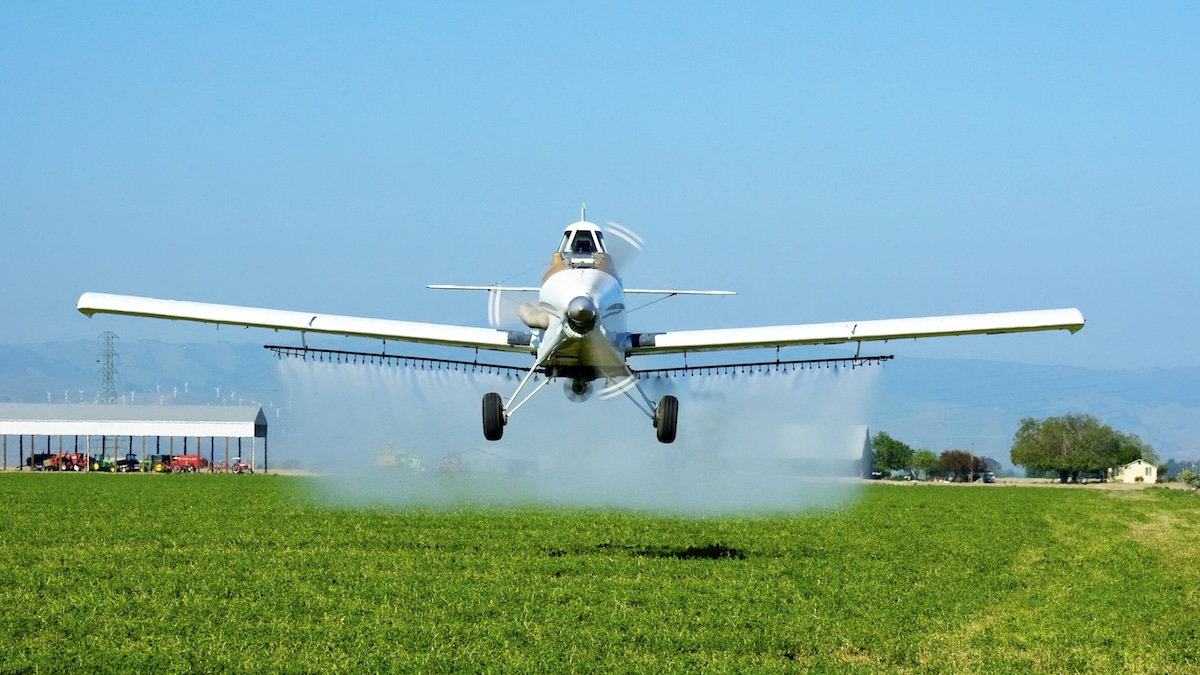A crop duster sprays an alfalfa field by the city of Tracy in California’s San Joaquin County. Bill & Brigitte Clough / Design Pics Editorial / Universal Images Group via Getty Images
Founded in 2005 as an Ohio-based environmental newspaper, EcoWatch is a digital platform dedicated to publishing quality, science-based content on environmental issues, causes, and solutions.
Pesticides are pervasive in the environment — not just as residue on the produce we eat, but in the air we breathe.
In the San Joaquin Valley of California, a new study by researchers at University of California, Davis (UC Davis) Health has found that 22 percent of adults who participated in an air-quality study, along with 10 percent of children, are breathing in detectable levels of pesticides, including the dangerous chemical chlorpyrifos that has been banned in the state.
“Although the cohort in our study was small, the findings are significant because they show children and adults in agricultural regions of the San Joaquin Valley of California continue to be exposed to pesticides and herbicides. This is despite efforts to decrease their use,” said lead author of the study Deborah H. Bennett, an environmental health professor at the Department of Public Health Services at UC Davis School of Medicine, in a press release from UC Davis.
California is a heavily agricultural state that puts millions of pounds of toxic chemical pesticides on its crops each year.
In 2022, five of the state’s top six counties using the highest amount of pesticides — Fresno, Kern, Madera, San Joaquin and Tulare — were located in the San Joaquin Valley, according to California Department of Pesticide Regulation data.
The research team gave backpacks with air-collection tubes to 11 children and 31 adults living in three agricultural towns in the valley. The tubes, located on the shoulder straps of the backpacks, allowed air samples to be taken by the study’s participants.
Each participant wore one of the backpacks eight to 14 hours a day for one to three days. The air samples were taken over a combined total of 92 days.
The researchers found that seven adults — 22 percent — and one child were exposed to pesticide levels detectable by the sensors.
The pesticides they found included chlorpyrifos — used since the 1960s and associated with neurologic damage in children and sensitive people; the fungicide pyrimethanil; burprofezin, an insecticide; 1,3-dichloropropene, a parasitic worm-targeting pesticide; the fungicide penthiopyrad, used in the prevention of mold and mildew; and trifluralin, a grass and weed killer.
By the time the samples were collected, California had banned chlorpyrifos.
While the toxicity of some of the detected compounds has been shown through studies, the potential adverse effects of others on humans is unknown.
“We need to expand community measuring and monitoring of chemicals routinely used in agriculture,” Bennett said in the press release. “New studies are also needed to evaluate the potential toxicity of the chemicals people in California’s agricultural communities are routinely exposed to.”
Study participants acted as citizen scientists, wearing the sample-collecting backpacks while going about their everyday lives.
“Many people in agricultural communities are very concerned about pesticide exposure,” said study co-author Jane Sellen, co-director of Californians for Pesticide Reform, in the press release. “They were happy to work with the scientists to collect this much needed data. Even with a small sample size, the results were alarming but not surprising.”
The study, “Personal air sampling for pesticides in the California San Joaquin Valley,” was published in the Journal of Exposure Science & Environmental Epidemiology.
Subscribe to get exclusive updates in our daily newsletter!
By signing up, you agree to the Terms of Use and Privacy Policy & to receive electronic communications from EcoWatch Media Group, which may include marketing promotions, advertisements and sponsored content.
